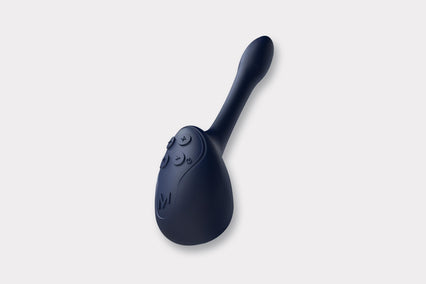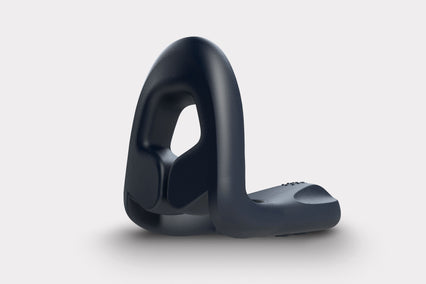Wouldn't it be nice if you and your partner had perfectly matched sex drives? When you're in the mood, so are they; when you're not in the mood, they show no interest. Unfortunately, in reality, it doesn't always work out that nicely.
One study found that around 25% of couples experienced a problematic libido discrepancy. If you’re struggling with sex drive differences in your relationship, you're in good company, and there are many actionable things and techniques to navigate the difference. Like many things in a relationship, healthy sex is about compromise and communication, and a little creativity doesn't hurt, either.
Common sex drive differences
We've all heard it before: men always want sex, and women rarely do. But real-life sexual desire doesn't fit neatly into stereotypes. Libido is influenced by biology, emotions, relationships, and life circumstances - factors that can affect everyone, no matter their gender.
Is libido really about gender?
The stereotype is reinforced in part by some studies that report that men tend to have higher spontaneous desire more frequently than women, but this doesn't tell the whole story, as conceptualizing sex drive is still something researchers are grappling with. For example, research found that about 15% of men reported experiencing low sexual desire, highlighting that low libido is definitely not just a woman's issue.
Similarly, studies indicate that women can experience desire differently, not necessarily less frequently. According to one study, women's sexual desire is often more responsive to relationship satisfaction, emotional connection, and other external factors rather than spontaneous, and this isn’t to say that those same things aren’t a factor that influences male sex drive too.
Relying on gender stereotypes around sex drives can create unnecessary stress. Instead of assuming who wants sex more based on gender, it's healthier to communicate openly about your individual desires, needs, and expectations. Libido naturally fluctuates because of relationship dynamics, stress, mental health, and more - factors affecting everyone equally. Embracing these differences without assumptions can lead to deeper intimacy and a more fulfilling sex life.
Does age affect sex drive?
You might’ve heard it said that men hit peak libido in their twenties while women peak later, but it's more varied than that.
Ultimately, age can influence sex drive - but not dictate it.
A review of lifespan studies shows men tend to report highest sexual desire around age 25–29, while women often show their strongest desire between ages 30–34. This pattern supports the idea that sexual peaks aren’t universally different by gender, just different by individual and context.
For example, testosterone declines gradually, roughly 1% per year after age 40, which can impact libido over time. And women may experience more abrupt drops in sexual desire during perimenopause and menopause due to hormonal changes, especially when estrogen levels fall.
Everyone’s libido journey looks different, and both men and women experience shift with age, life, and hormones change. It’s not uncommon for desire patterns to overlap, or flip, across gender lines.
What to do when you're living with sex drive differences
Even knowing how common sex drive differences are doesn't automatically make it easier to deal with in your relationship. Both the partner with the higher sex drive and the partner with the lower sex drive may struggle with feeling unfulfilled, misunderstood, or unappreciated. The partner with the high sex drive may feel driven to engage in more sexual activity and frustrated by a lack of participation or willingness from their partner, while the partner with lower sex drive may feel consistently pressured or worry about disappointing their partner. Fortunately, there are tips and techniques you can use to decrease the problems that can come about from mismatched sex drive in your relationship.
1. Identify the reasons behind your differences
Some sex drive differences are lifelong challenges for couples who live with them. In many cases, one member of your partnership simply has a higher sex drive than the other. That partner may naturally be more sexual and want to engage in more sex.
Other times, however, there's something else that accounts for significantly lower libido in one partner. In fact, the partner with the higher sex drive in your relationship can fluctuate significantly through the years. Take a look at things like:
- Stress levels
- Illness
- Feeling otherwise disconnected from the relationship
- Distraction
- Depression or anxiety
- An appearance of disinterest due to prior performance issues or struggles
Sometimes, identifying the reasons behind sex drive differences can give you the chance to fix some of those differences. For example, if you discover that one partner has a lower sex drive due to distraction over piles of chores, simply taking over some of those responsibilities might just help revitalize your sex life. You might also find that your partner's sexual desire is more intense during a different time of the day, making it worth changing your routine to get the sex you crave. Other times, simply understanding the difference between your sexual desires can make it easier not to take a denial- or the pressure for sex- personally.
2. Get to know how you and your partner experience love
There's a lot of hype out there about love languages, but there's a reason behind the hype: different people experience love in different ways and, unsurprisingly, a lot of people with high sex drives experience love through physical touch. Your sex drive - or lack thereof - does not, however, automatically define your love language. In fact, when you really start digging, you may be surprised by what communicates love to you the most.
When you understand how your partner experiences love, you can do a better job of meeting their needs. For the partner with a lower sex drive, meeting their needs can increase that sense of connection and, often, increase desire. Who would have thought that complimenting your spouse, or taking care of a few chores around the house, or bringing home flowers could substantially increase sexual desire? On the other hand, the partner with the high sex drive may feel more satisfied with the relationship in general when those other needs are being met.
Even if you experience love most through physical touch and have a higher sex drive than your partner, you may find that you feel more satisfied when your partner physically expresses love in other ways. Receiving a massage, cuddling on the couch, or holding hands as you walk down the street together can all help you feel more physically connected without requiring as much sex.
3. Make a conscious effort to set aside time for sex
Sometimes, today's busy schedules make it difficult to set aside time for sex with your partner- and you may find that it's difficult to find the energy to connect sexually at the end of a long, busy day. If a libido difference is starting to have a negative impact on your relationship, however, it's time to address it- and that may start with scheduling sex.
Set aside a specific time that's just for the two of you. Set an appointment for sex each week or each month, depending on where your sexual desires mesh. If you're the partner with the higher desire, try to do some things to take the pressure off for your partner, whether that means taking over a chore for them on those days or retiring to bed a little earlier (even if you have to turn off the television or stop scrolling social media to make it happen).
Three things happen when you deliberately make time for sex with your partner. For the partner with the lower libido, it can take some of the pressure off: that is, you may no longer feel as though every touch or look is an invitation to sex. For the partner with the higher libido, scheduling sex can make anticipation sweeter and take off some of the drive to push your partner toward sex every time you have a moment alone together. Having sex on a regular basis can also help increase the sex drive of the partner with lower libido.
4. Find ways to compromise
In any relationship, you're going to make a lot of compromises. However, because sex is so highly personal - and such an important part of your connection - it can be difficult to reach a compromise, especially if you feel that your needs or desires are being ignored. However, there are several ways you can find a happy medium in your sexual relationship- one that satisfies both of you. Try some of these suggestions:
Ask if the partner with the lower sex drive will "help out" the partner with the higher drive, whether that’s mutual masturbation instead of penetrative sex, oral sex, or a hand job, there are many ways to connect sexually that your partner may be more willing to try.
Use a vibrator to masturbate. Sometimes, the partner with the higher sex drive may find that masturbation helps satisfy the urge and decreases urgency. A vibrator can also help ramp up pleasure for the partner with lower sexual desire.
Likewise, sometimes the partner with the lower sex drive may not find sex stimulating without more stimulation. Using a couple’s vibrator like Tenuto 2 provides arousal to both partners at the same time during sex, making sex something you both look forward to.
5. Experiment with new things
Break out of the mold and try something different. Talk with your partner about fantasies you might like to try out together. Try something that excites you both. Sometimes, just talking about your fantasies with your partner can increase arousal and interest. Other times, you may find that acting out a fantasy brings new excitement and enjoyment to the bedroom, which can help increase interest in the partner with lower libido. You may also discover that experimentation and communication increase your partner's enjoyment of sex, which can naturally enhance sex drive. Try out new sex positions. If your sex routine typically starts and ends with penetration-based sex, try non-penetrative sex for a change.
Takeaway
Having mismatched sex drives can feel frustrating, but it doesn't mean there's something wrong with you or your relationship. Often, a little creativity and open communication can go a long way. If you're curious about spicing things up or just looking for an easy way to feel more connected, try using a couples vibrator to get both of you back on the same page – sexually speaking. It's a simple, pleasurable way to bridge the gap and enhance intimacy together.















































